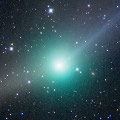
|
It kept as bright as 6-7 mag for a long time from 2011 summer to 2012 spring. Now it is fading. But it is bright as 10.0 mag still now (May 27, Salvador Aguirre). It will be unobservable soon in late June. But it will appear in the morning sky again at 12.5 mag in October.
Date(TT) R.A. (2000) Decl. Delta r Elong. m1 Best Time(A, h)
June 9 9 0.66 24 1.1 3.172 2.680 52 10.2 18:25 (142, 20)
June 16 9 4.49 22 13.4 3.335 2.748 47 10.4 18:25 (136, 19)
|
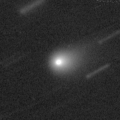
|
Already so bright as 11.1 mag (May 14, Juan Jose Gonzalez). It is expected to be bright as 9 mag from 2012 to 2013. In the Northern Hemisphere, it keeps observable in good condition for a long time until 2012 autumn when the comet brightens up to 10 mag. In the Southern Hemisphere, it is hardly observble before the perihelion passage. But it becomes observable in good condition since 2013 after the perihelion passage.
Date(TT) R.A. (2000) Decl. Delta r Elong. m1 Best Time(A, h)
June 9 14 14.60 51 5.4 2.853 3.136 96 11.7 21:01 (180, 4)
June 16 14 9.50 49 7.6 2.833 3.074 93 11.6 20:29 (180, 6)
|
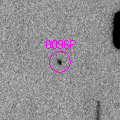
|
It has brightened up to 16.5 mag on June 1 (Martin Masek, et al.). Brightening rapidly. It will approach to the sun down to 0.12 A.U. on July 14. In the Southern Hemisphere, it keeps observable in good condition except for mid July only, in the morning sky before the perihelion passage, and in the evening sky after the perihelion passage. In the Northern Hemisphere, it is not observable before the perihelion passage. But it will appear in the evening sky at 8 mag in late July. Then it keeps observable while fading rapidly in the evening low sky.
Date(TT) R.A. (2000) Decl. Delta r Elong. m1 Best Time(A, h)
June 9 2 51.73 -27 24.0 1.044 1.035 60 13.0 5:33 (280, 37)
June 16 3 42.37 -21 37.6 0.968 0.888 53 12.0 5:35 (276, 31)
|

|
Big asteroid discovered in 1906. It suddenly showed the cometary activity on Dec. 11, 2010, probably due to an impact of a small object. Now it is 12.0 mag (May 27, Marco Goiato). It has already turned to be stellar.
Date(TT) R.A. (2000) Decl. Delta r Elong. m1 Best Time(A, h)
June 9 16 24.50 -22 20.7 1.441 2.447 169 12.0 23:11 (180, 77)
June 16 16 18.02 -22 55.0 1.463 2.448 161 12.2 22:37 (180, 78)
|

|
Now it is bright as 13 mag (May 19, Terry Lovejoy). It is expected to be observable at 11-13 mag for a long time from 2012 summer to 2013 summer. It will be observable in excellent condition in the Southern Hemisphere. But it is not observable until 2013 January in the Northern Hemisphere.
Date(TT) R.A. (2000) Decl. Delta r Elong. m1 Best Time(A, h)
June 9 3 1.38 -42 34.2 2.724 2.594 71 12.8 5:33 (299, 40)
June 16 3 15.14 -45 6.2 2.597 2.547 75 12.6 5:35 (302, 44)
|
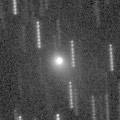
|
It brightened much faster than expected. Now it is so bright as 11.2 mag (May 14, Juan Jose Gonzalez). In the Northern Hemisphere, it keeps observable at 12-13 mag in good condition until early 2013. In the Southern Hemisphere, it is not observable until late 2012.
Date(TT) R.A. (2000) Decl. Delta r Elong. m1 Best Time(A, h)
June 9 7 24.26 80 8.7 2.541 2.197 59 12.7 18:25 (170,-30)
June 16 8 4.76 76 10.6 2.581 2.180 55 12.7 18:25 (166,-27)
|
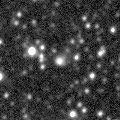
|
It is expected to be a great comet of -1 mag in 2013 spring. Now it is 12.6 mag (May 28, Jakub Cerny). Brightening faster than originally expected. In 2012, it keeps observable until summer while brightening gradually. It locates somewhat low in the Northern Hemisphere.
Date(TT) R.A. (2000) Decl. Delta r Elong. m1 Best Time(A, h)
June 9 15 56.65 -25 50.9 3.381 4.362 163 13.0 22:43 (180, 81)
June 16 15 47.77 -25 45.2 3.343 4.283 154 12.9 22:07 (180, 81)
|
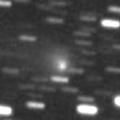
|
Now it is bright as 12.9 mag (May 28, Jakub Cerny). It keeps 13-14 mag and observable in good condition until September.
Date(TT) R.A. (2000) Decl. Delta r Elong. m1 Best Time(A, h)
June 9 16 35.96 -12 26.8 4.154 5.147 166 13.4 23:22 (180, 67)
June 16 16 25.32 -12 19.8 4.188 5.152 159 13.4 22:44 (180, 67)
|
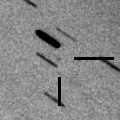
|
It will brighten up to 14 mag from May to July. It has not been observed since late January, but it must be already bright at 15 mag. In the Southern Hemisphere, it has been extremely low, but it will be getting higher gradually after this, and will be observable in good condition. It will be hardly observable in the Northern Hemisphere.
Date(TT) R.A. (2000) Decl. Delta r Elong. m1 Best Time(A, h)
June 9 4 42.63 -41 53.0 0.981 1.075 65 13.8 5:33 (306, 23)
June 16 5 58.82 -46 38.1 0.870 1.090 70 13.6 18:25 ( 49, 24)
|
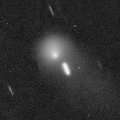
|
Now it is bright as 13.3 mag (Apr. 15, Jakub Cerny). It keeps bright as 13-14 mag for a long time after this until 2013. It is not observable in the Northern Hemisphere, but it is observable in good condition in the Southern Hemisphere.
Date(TT) R.A. (2000) Decl. Delta r Elong. m1 Best Time(A, h)
June 9 4 17.68 -53 31.0 5.716 5.580 77 13.6 5:33 (316, 31)
June 16 4 24.17 -53 4.9 5.712 5.592 78 13.6 5:35 (315, 34)
|

|
This comet brightened up to 10 mag in outburst in 1995, however, it became lost after that. The condition of this apparition is bad. It is not observable around the perihelion passage. Maybe it can be recovered after summer when it appears in the morning sky.
Date(TT) R.A. (2000) Decl. Delta r Elong. m1 Best Time(A, h)
June 9 3 49.22 12 13.3 2.440 1.545 21 13.8 5:33 (252, 4)
June 16 4 9.69 12 51.8 2.461 1.583 23 13.7 5:35 (250, 5)
|
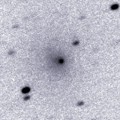
|
Another small outburst occured on May 1. It is still lbright as 12.8 mag (May 18, Jakub Cerny).
Date(TT) R.A. (2000) Decl. Delta r Elong. m1 Best Time(A, h)
June 9 12 5.30 -10 10.3 5.888 6.256 106 13.8 18:53 (180, 65)
June 16 12 6.13 -10 7.7 5.994 6.256 100 13.9 18:26 (180, 65)
|

|
It kept as bright as 11-12 mag for a long time from 2011 autumn to 2012 spring. It is not observable now. But it will appear in the morning sky again at 15 mag in autumn.
Date(TT) R.A. (2000) Decl. Delta r Elong. m1 Best Time(A, h)
June 9 6 12.04 19 17.6 3.298 2.333 15 14.1 18:25 (111, -4)
June 16 6 27.04 19 7.4 3.344 2.360 12 14.2 18:25 (109, -6)
|
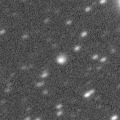
|
Now it is 13.9 mag (Mar. 26, Jakub Cerny). It is expected to be 13 mag and will be observable in good condition in 2013. It keeps observable for a long time in the Northern Hemisphere. It is not observable in the Southern Hemisphere.
Date(TT) R.A. (2000) Decl. Delta r Elong. m1 Best Time(A, h)
June 9 23 23.42 54 4.0 6.663 6.381 69 14.2 5:33 (186, 0)
June 16 23 19.89 54 42.7 6.572 6.363 73 14.1 5:35 (181, 0)
|

|
Now it is so bright as 11.8 mag (May 14, Juan Jose Gonzalez). Although it was extremely faint as 20.5 mag at the recovery in 2010 autumn, it brightened rapidly. It will keep 12-14 mag and observable in good condition for a long time from 2012 to 2013. But it locates somewhat low in the Northern Hemisphere in 2013.
Date(TT) R.A. (2000) Decl. Delta r Elong. m1 Best Time(A, h)
June 9 12 51.00 11 5.4 2.663 3.132 108 14.2 19:38 (180, 44)
June 16 12 52.36 10 7.6 2.737 3.119 102 14.3 19:12 (180, 45)
|
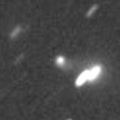
|
Now it is 15.3 mag (May 30, Jakub Cerny). After this, it will be observable in good condition in the Southern Hemisphere while fading gradually. It will locate somewhat low in the Northern Hemisphere. In 2011, some visual observers reported it was very bright as 10-12 mag.
Date(TT) R.A. (2000) Decl. Delta r Elong. m1 Best Time(A, h)
June 9 23 2.95 -15 34.4 2.730 3.034 97 14.9 5:33 (194, 70)
June 16 23 7.80 -16 13.6 2.685 3.081 103 15.0 5:30 (180, 71)
|
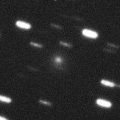
|
It was observed at 12.5 mag on Apr. 1, as bright as expected (Michael Jager). Now it is 14.0 mag (Apr. 26, Michael Jager). In the Northern Hemisphere, it locates extremely low in the morning until June. It will be observable at high location after summer. In the Southern Hemisphere, it will never be observable again.
Date(TT) R.A. (2000) Decl. Delta r Elong. m1 Best Time(A, h)
June 9 3 21.39 42 42.2 3.205 2.379 29 15.0 5:33 (224,-10)
June 16 3 37.79 43 26.6 3.254 2.452 31 15.2 5:35 (222, -9)
|
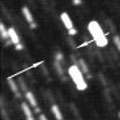
|
Now it is 16.6 mag (Apr. 18, Jakub Cerny). In the Southern Hemisphere, it will be observable at 15-16 mag in good condition for a long time until 2013 summer. It is not observable at all in the Northern Hemisphere.
Date(TT) R.A. (2000) Decl. Delta r Elong. m1 Best Time(A, h)
June 9 20 44.31 -68 43.2 3.279 3.939 124 15.0 3:35 ( 0, 56)
June 16 20 41.13 -71 9.4 3.250 3.930 125 15.0 3:04 ( 0, 54)
|

|
The condition of this apparition is bad, and it was not observable around the perihelion passage. Appearing in the morning sky now. It is bright still now, about 14 mag (May 16, Terry Lovejoy). But it still locates extremely low in the Northern Hemisphere.
Date(TT) R.A. (2000) Decl. Delta r Elong. m1 Best Time(A, h)
June 9 1 12.30 -0 43.8 2.508 2.226 62 15.5 5:33 (234, 41)
June 16 1 21.95 0 7.3 2.472 2.265 66 15.6 5:35 (227, 44)
|
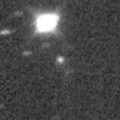
|
Now it is 16.1 mag (May 10, M. Jaeger, et al.). It will brighten up to 13.5 mag from summer to autumn. It keeps observable for a long time until December. In the Northern Hemisphere, it locates high until spring. But after that, it keeps locating low in the evening. In the Southern Henmisphere, it keeps locating low all through the time.
Date(TT) R.A. (2000) Decl. Delta r Elong. m1 Best Time(A, h)
June 9 11 7.00 32 51.4 2.027 2.058 77 15.7 18:25 (173, 22)
June 16 11 15.16 31 42.8 2.024 1.986 73 15.5 18:25 (169, 22)
|

|
Hidetaka Sato observed it at 18.6 mag on May 27. It is expected to brighten rapidly and to reach up to 10 mag in August. It keeps observable in the morning sky all through this apparition, although it locates somewhat low.
Date(TT) R.A. (2000) Decl. Delta r Elong. m1 Best Time(A, h)
June 9 0 16.80 16 35.0 1.290 1.317 68 16.3 5:33 (207, 34)
June 16 0 47.13 19 16.5 1.226 1.254 67 15.6 5:35 (206, 31)
|
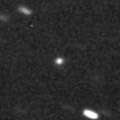
|
Bright new comet. Now it is 16.1 mag (May 14, P. Birtwhistle). It keeps observable in good condition at 14-15 mag for a long time until winter. It locates somewhat low in the Southern Hemisphere.
Date(TT) R.A. (2000) Decl. Delta r Elong. m1 Best Time(A, h)
June 9 23 16.18 30 14.8 3.688 3.604 77 15.9 5:33 (188, 24)
June 16 23 22.37 31 28.2 3.583 3.573 81 15.8 5:35 (182, 23)
|

|
First return of a new periodic comet which brightened up to 14 mag in 2005. It was recovered as bright as predicted. Now it is 17.5 mag (May 18, Martin Masek). It is expected to brighten up to 13 mag from summer to autumn, and will be observable in excellent condition. Now it locates high in the Southern Hemisphere.
Date(TT) R.A. (2000) Decl. Delta r Elong. m1 Best Time(A, h)
June 9 23 31.46 -17 0.1 1.460 1.803 91 16.4 5:33 (214, 69)
June 16 23 45.83 -15 5.0 1.369 1.765 94 16.1 5:35 (202, 69)
|

|
Dave Herald observed it at 18.6 mag on May 27. It will approach to the earth down to 0.17 A.U. in July. Then it brightens up to 15 mag and moves northwards very quickly. Now it locates very high in the Southern Hemisphere, but not observable in the Northern Hemisphere. In the Northern Hemisphere, it will become observable in late June, then it will be observable in excellent condition. In the Southern Hemisphere, it keeps excellent condition until July. It keeps observable also after that, but locates somewhat low.
Date(TT) R.A. (2000) Decl. Delta r Elong. m1 Best Time(A, h)
June 9 17 56.90 -57 24.5 0.309 1.280 144 17.0 0:47 ( 0, 67)
June 16 18 8.54 -52 26.0 0.261 1.249 150 16.5 0:31 ( 0, 72)
|
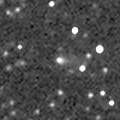
|
Now it is 16.3 mag (Apr. 24, V. Gerke, A. Novichonok, S. Plaksa). It tends to brighten after the perihelion passage. It keeps observable at 17 mag from 2012 to 2013. It locates somewhat low in the Northern Hemisphere.
Date(TT) R.A. (2000) Decl. Delta r Elong. m1 Best Time(A, h)
June 9 16 19.27 -15 50.6 2.125 3.121 166 16.7 23:06 (180, 71)
June 16 16 14.88 -16 3.5 2.149 3.119 159 16.7 22:34 (180, 71)
|

|
Now it is 17.2 mag (May 27, P. Birtwhistle). It is expected to approach to the earth and to be observable at 9-10 mag in good condition in winter. The condition is good in the Northern Hemisphere. It locates low in the Southern Hemisphere, and will be unobservable after summer. But it will become observable in good condition after 2013 January.
Date(TT) R.A. (2000) Decl. Delta r Elong. m1 Best Time(A, h)
June 9 18 59.30 33 54.2 2.092 2.714 117 16.9 1:50 (180, 21)
June 16 18 44.90 37 13.0 2.008 2.636 117 16.7 1:08 (180, 18)
|
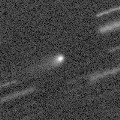
|
Now it is 16.7 mag (Apr. 14, Yasukazu Ikari). It keeps observable at 17 mag for a long time from 2011 to 2013. In 2012, it keeps observable in good condition until early September.
Date(TT) R.A. (2000) Decl. Delta r Elong. m1 Best Time(A, h)
June 9 14 52.11 8 30.1 4.871 5.623 133 16.9 21:38 (180, 47)
June 16 14 44.49 8 31.1 4.957 5.625 126 17.0 21:03 (180, 47)
|
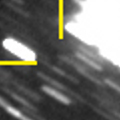
|
It was predicted to brighten up to 17 mag and will be observable in good condition from spring to summer. But actually, Juro Kobayashi reported it as around 19 mag on Apr. 28, and Dave Herald reported it as 19.5-20.0 mag in early June, much fainter than this ephemeris.
Date(TT) R.A. (2000) Decl. Delta r Elong. m1 Best Time(A, h)
June 9 19 35.02 -5 59.9 1.312 2.196 141 17.0 2:25 (180, 61)
June 16 19 32.23 -5 40.6 1.291 2.215 147 16.9 1:55 (180, 61)
|
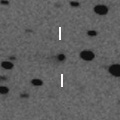
|
It keeps 17 mag for a long time from 2009 to 2013.
Date(TT) R.A. (2000) Decl. Delta r Elong. m1 Best Time(A, h)
June 9 23 39.99 14 7.7 8.479 8.321 77 17.3 5:33 (198, 39)
June 16 23 38.55 14 16.4 8.370 8.333 84 17.3 5:35 (188, 40)
|

|
Now it is 20.0 mag (May 27, Hidetaka Sato), much fainter than expected. But it is expected to brighten rapidly, and to be observable in good condition at 16.5 mag from summer to autumn.
Date(TT) R.A. (2000) Decl. Delta r Elong. m1 Best Time(A, h)
June 9 23 13.37 -12 39.0 1.912 2.227 94 17.9 5:33 (199, 67)
June 16 23 21.39 -11 13.4 1.817 2.207 98 17.7 5:35 (185, 66)
|

|
New comet. It is expected to brighten up to 10 mag from winter to spring in 2013, and will be observable in good condition. In the Northern Hemisphere, it keeps observable until around the perihelion passage. In the Southern Hemisphere, it will be observable after the perihelion passage.
Date(TT) R.A. (2000) Decl. Delta r Elong. m1 Best Time(A, h)
June 9 23 45.77 69 52.4 4.461 4.143 65 17.9 5:33 (185,-16)
June 16 23 56.88 71 24.9 4.369 4.072 66 17.8 5:35 (184,-17)
|

|
New comet. It will brighten up to 15 mag from autum to winter. In the Northern Hemisphere, it keeps observable for a long time until the comet fades out. It is not observable in the Southern Hemisphere, except for 2013 spring, but the comet locates extremely low only.
Date(TT) R.A. (2000) Decl. Delta r Elong. m1 Best Time(A, h)
June 9 19 22.15 69 40.8 3.099 3.166 84 18.0 2:12 (180,-15)
June 16 19 3.79 72 19.1 3.068 3.116 83 17.9 1:27 (180,-17)
|
|
![]()
 29P/Schwassmann-Wachmann 1
29P/Schwassmann-Wachmann 1 78P/Gehrels 2
78P/Gehrels 2 C/2010 S1 ( LINEAR )
C/2010 S1 ( LINEAR ) 246P/2010 V2 ( NEAT )
246P/2010 V2 ( NEAT ) C/2011 A3 ( Gibbs )
C/2011 A3 ( Gibbs ) C/2011 Q2 ( McNaught )
C/2011 Q2 ( McNaught ) C/2011 O1 ( LINEAR )
C/2011 O1 ( LINEAR ) 71P/Clark
71P/Clark C/2012 CH17 ( MOSS )
C/2012 CH17 ( MOSS ) 185P/Petriew
185P/Petriew C/2012 J1 ( Catalina )
C/2012 J1 ( Catalina ) 260P/2012 K2 ( McNaught )
260P/2012 K2 ( McNaught ) 189P/NEAT
189P/NEAT 152P/Helin-Lawrence
152P/Helin-Lawrence C/2012 K5 ( LINEAR )
C/2012 K5 ( LINEAR ) C/2010 R1 ( LINEAR )
C/2010 R1 ( LINEAR ) 105P/Singer Brewster
105P/Singer Brewster C/2008 S3 ( Boattini )
C/2008 S3 ( Boattini ) 160P/LINEAR
160P/LINEAR C/2012 L2 ( LINEAR )
C/2012 L2 ( LINEAR ) C/2012 L1 ( LINEAR )
C/2012 L1 ( LINEAR )![]()























